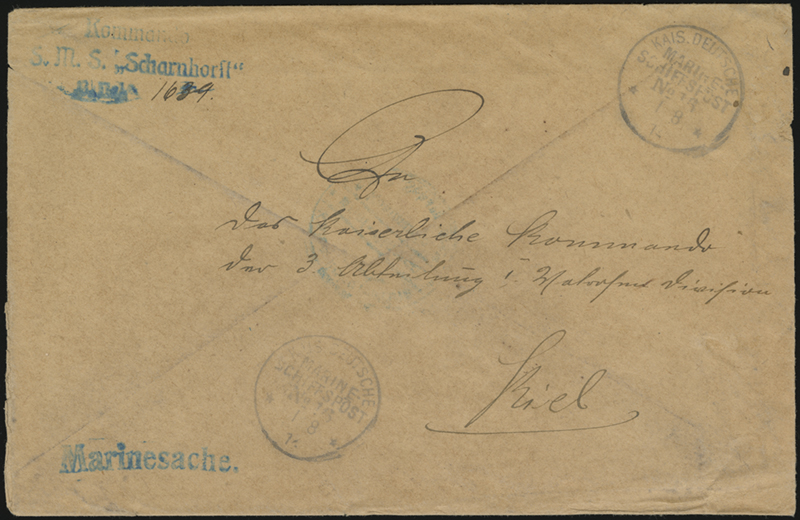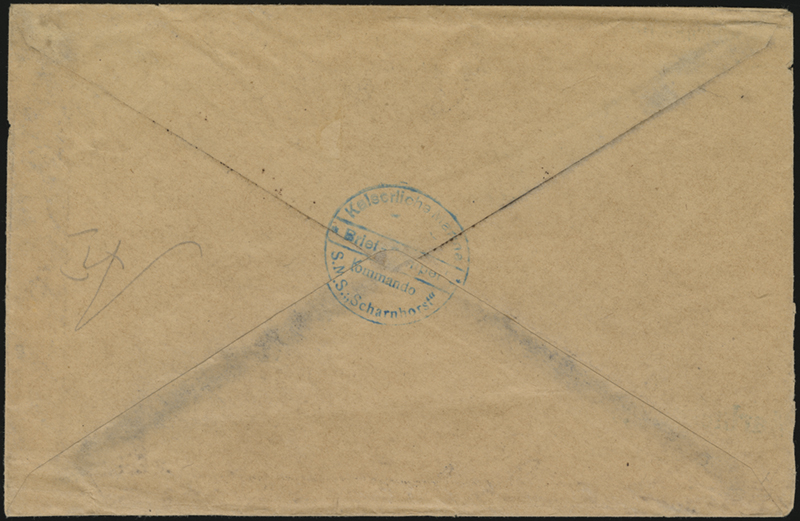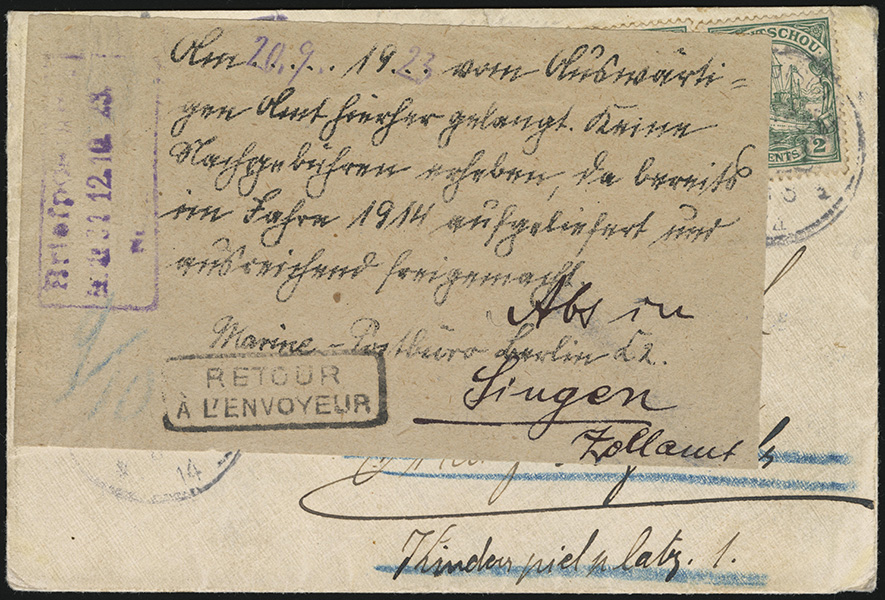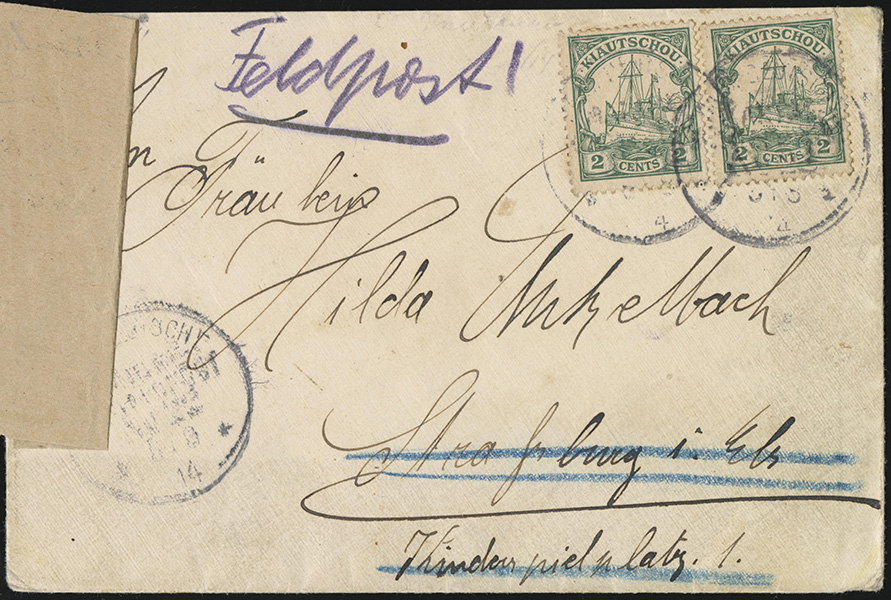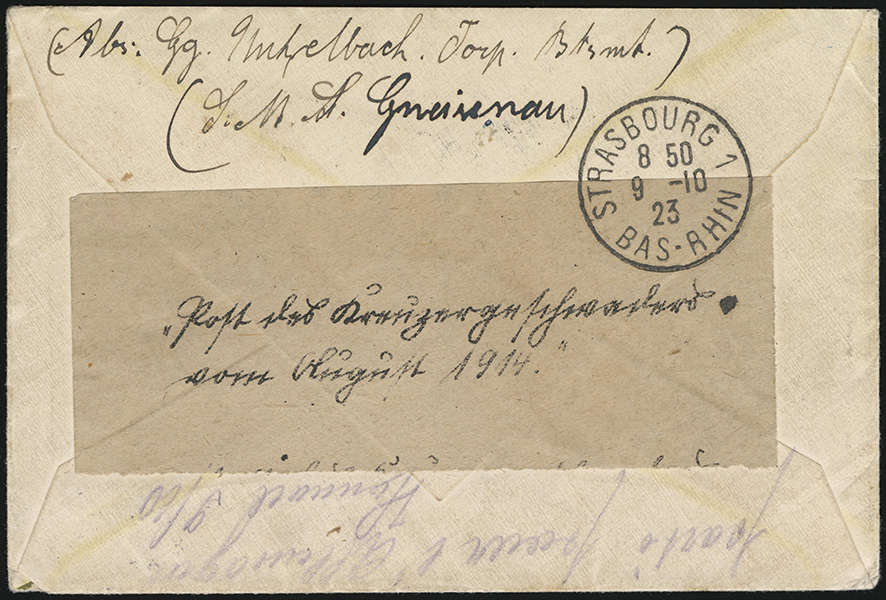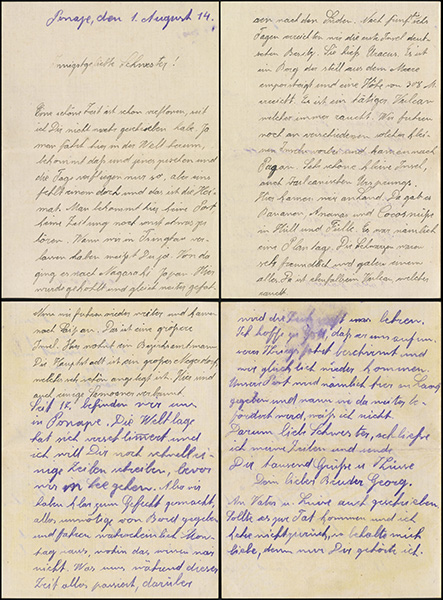Post by PostmasterGS on Apr 1, 2022 21:05:08 GMT
I received an extremely rare one in the mail today, so here's another interesting bit of philatelic history.
Historical Background
During the German colonial period (1880s to WWI), the Imperial German Navy posted squadrons of ships to several stations around the world. These ships served as a means of projecting German military power in and around their colonies.
One of the stations to which ships were posted was the Deutsch Ostasiatische Station (German East Asian Station) in Tsingtau, Kiauchau (modern Qingdao, PRC). This ships assigned to the Ostasiatische Station routinely patrolled from China to the German colonies in the South Pacific -- Marshall-Inseln (Marshall Islands), Marianen (Mariana Islands), Karolinen (Caroline Islands), Samoa, Deutsch-Neuguinea (German New Guinea). During these voyages, the crew's mail would typically be cancelled with the onboard Marine-Schiffspost (MSP, or Navy Ship Post) canceller, then either offloaded at commercial steamship ports of call or given to homeward-bound German naval vessels.
Many large and small ships rotated through the Ostasiatische Station over the years, but cruisers formed the core of the squadron due to their combination of size, firepower, and speed. In early 1914, the cruisers assigned to the East Asia Squadron were the armored cruisers SMS Scharnhorst (flagship) and SMS Gneisenau, and the light cruisers SMS Leipzig, SMS Nürnberg, and SMS Emden. NOTE: Histories sometimes refer to this squadron as Kreuzergeschwader von Spee (Cruiser Squadron von Spee), after its commander at the time, Count Maximilian von Spee.

Five cruisers of the East Asia Squadron at anchor in Kiauchau (SMS Scharnhorst and SMS Gneisenau at center, SMS Leipzig? at left, SMS Emden and SMS Nürnberg at right)

SMS Scharnhorst (left) and SMS Gneisenau (right)

SMS Nürnberg (left), SMS Leipzig (center), and SMS Emden (right)
The Summer Cruise
On 20 June 1914, SMS Scharnhorst and SMS Gneisenau departed for a routine cruise throughout the South Seas colonies. At the same time, the SMS Leipzig was off the west coast of the US, the SMS Nürnberg was returning to Tsingtau from the same, and the SMS Emden was in Tsingtau.
On 15 July 1914, while at Truk, Karolinen (modern Chuuk, Federated States of Micronesia), SMS Scharnhorst and SMS Gneisenau received word that war was imminent. They were ordered to break-off their patrol and make for Ponape, Karolinen (modern Pohnpei, FSM), where they were to await further orders.
On 6 August 1914, the SMS Nürnberg arrived at Ponape, and the three cruisers immediately departed for Pagan, Marianen (modern Pagan, Northern Mariana Islands), where they were to rendezvous with the SMS Emden before heading off to war.
The Mail Drop
Prior to departing Ponape, however, the three cruisers offloaded their accumulated outgoing mail. This mail drop was particularly important, as the men knew it might be their last opportunity to write home before going into combat, and many of the men had included their wills in the correspondence. Earlier-dated items were franked as normal for pre-war German naval mail, while mail from 5-6 August 1914 was unfranked as Feldpost mail.
On 6 August 1914, this mail was put into five mail bags, which were then placed in a tin box and given to the German postal agent at Ponape, Herr Ludwig, who was to send the mail to Germany at the first opportunity. However, the steamer service which Ponape relied upon for mail service was disrupted due to the onset of war. In early October 1914, Herr Ludwig, realizing there would be no mail steamer pickup before Japanese forces arrived to take the island, gave the mail to local Capuchin monks, who buried the tin box under the altar of the Catholic church.
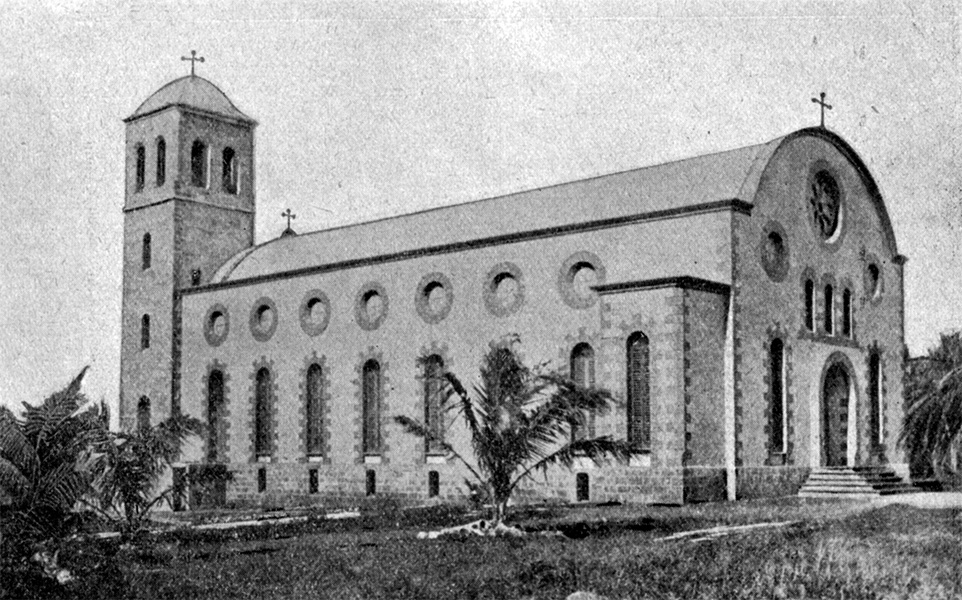
German-built Catholic Church at Ponape
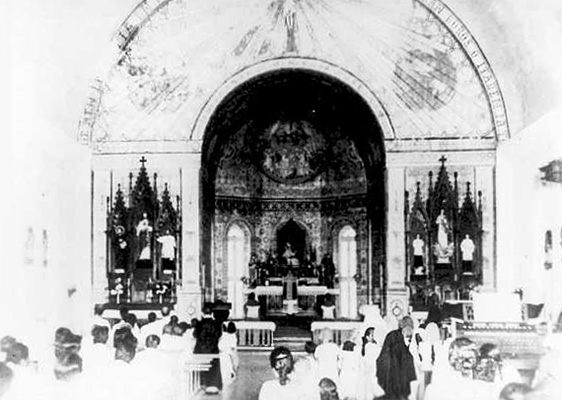
Altar of the Catholic Church at Ponape
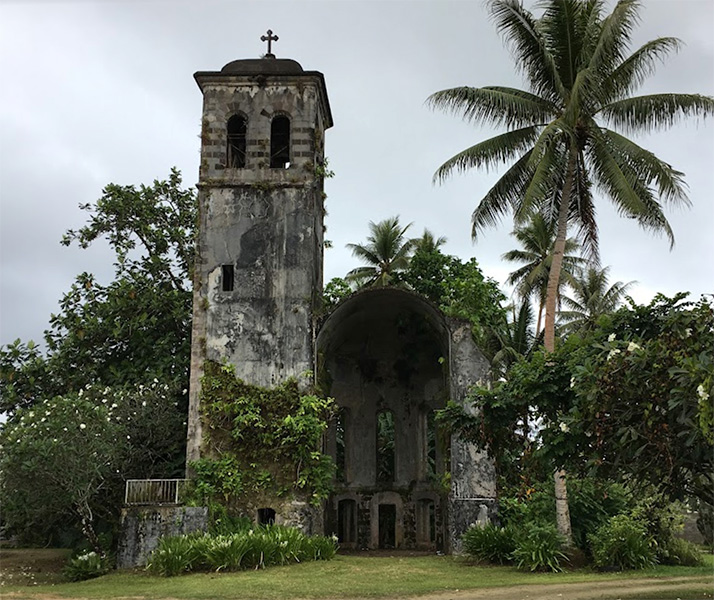
Remains of the Catholic Church, which was largely destroyed during WWII while being used as a storage depot by the Japanese
And there the mail stayed...
Aftermath
The cruisers of the East Asia Squadron would not survive much longer. After successfully confusing the British about their location for several months, the cruisers (minus SMS Emden) won a stunning victory over the Royal Navy at the Battle of Coronel off the coast of Chile on 1 November 1914, but were then sunk at the Battle of the Falkland Islands on 8 December 1914. The SMS Emden enjoyed several months of commerce raiding in the Indian Ocean before being defeated at the Battle of Cocos and run aground in the Cocos Islands by the Australian cruiser HMAS Sydney on 9 November 1914.
Recovering the Buried Mail
In early 1923, the German embassy in Tokyo formally requested permission from the Japanese government to return and retrieve the buried mail. The tin box was recovered, and in September 1923, the Marine-Postbureau (Naval Post Office) in Berlin began efforts to deliver the long-overdue items. Two labels were attached to each. One label says, roughly:
The other states, roughly:
Many of the items were damaged by the passage of time in the poor environmental conditions, and discoloration and foxing are common. These buried mail pieces are among the rarest of items in German colonial philately. In all my references, there's no record of how many pieces survived. In 20+ years of collecting German colonies, this is only the second one I've seen available for sale or at auction.
My Copy
I recently acquired this copy, which is a photo postcard depicting the SMS Gneisenau (in fact, the same photo as shown above).
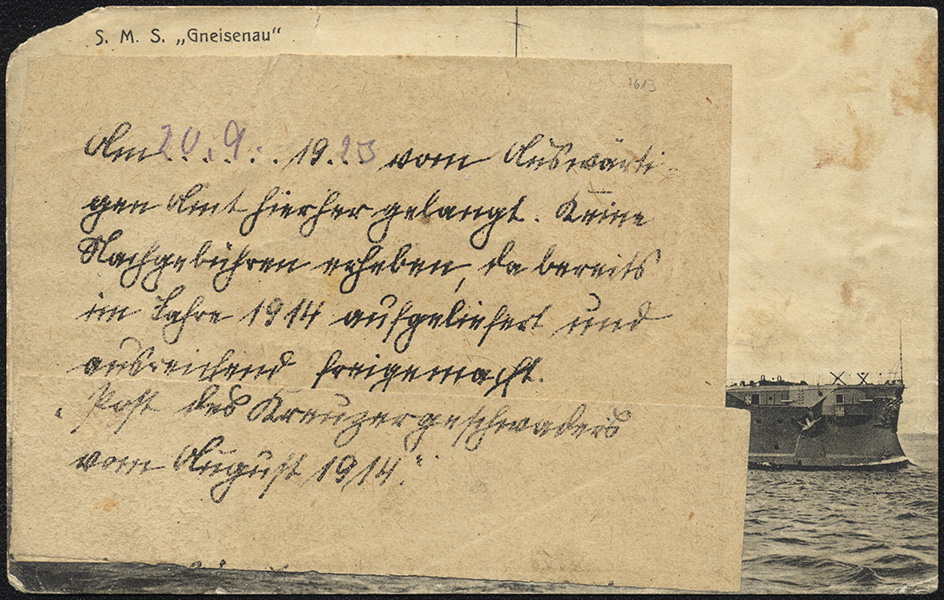
The postcard was cancelled on 5 August 1914, the day before the mail drop, with the MSP No. 22 canceller assigned to the SMS Gneisenau's on-board post office. As was allowed for items posted 5-6 August 1914, it was unfranked as Feldpost mail.
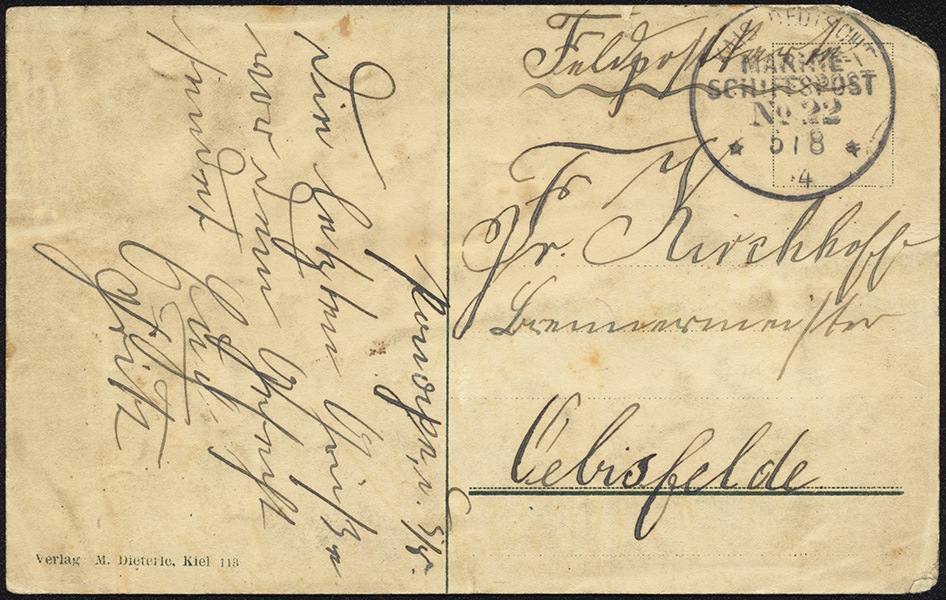
The card was sent by Friedrich "Fritz" Kirchhoff, a Torpedo Machinists Mate assigned to the 1st Company of the II. Torpedo Division on board the S.M.S. Gneisenau, to his father, also named Friedrich, in Oebisfelde, Germany.
The text reads, roughly:
When the S.M.S. Gneisenau sank during the Battle of the Falkland Islands, 187 of her approximately 600-man crew were rescued by the British. Fritz Kirchhoff was not among them. Along with the remaining unaccounted-for crewmembers, he was officially listed as missing in action in the Germany Navy's Casualty List Nr. 28a, dated 20 April 1915.

Historical Background
During the German colonial period (1880s to WWI), the Imperial German Navy posted squadrons of ships to several stations around the world. These ships served as a means of projecting German military power in and around their colonies.
One of the stations to which ships were posted was the Deutsch Ostasiatische Station (German East Asian Station) in Tsingtau, Kiauchau (modern Qingdao, PRC). This ships assigned to the Ostasiatische Station routinely patrolled from China to the German colonies in the South Pacific -- Marshall-Inseln (Marshall Islands), Marianen (Mariana Islands), Karolinen (Caroline Islands), Samoa, Deutsch-Neuguinea (German New Guinea). During these voyages, the crew's mail would typically be cancelled with the onboard Marine-Schiffspost (MSP, or Navy Ship Post) canceller, then either offloaded at commercial steamship ports of call or given to homeward-bound German naval vessels.
Many large and small ships rotated through the Ostasiatische Station over the years, but cruisers formed the core of the squadron due to their combination of size, firepower, and speed. In early 1914, the cruisers assigned to the East Asia Squadron were the armored cruisers SMS Scharnhorst (flagship) and SMS Gneisenau, and the light cruisers SMS Leipzig, SMS Nürnberg, and SMS Emden. NOTE: Histories sometimes refer to this squadron as Kreuzergeschwader von Spee (Cruiser Squadron von Spee), after its commander at the time, Count Maximilian von Spee.

Five cruisers of the East Asia Squadron at anchor in Kiauchau (SMS Scharnhorst and SMS Gneisenau at center, SMS Leipzig? at left, SMS Emden and SMS Nürnberg at right)

SMS Scharnhorst (left) and SMS Gneisenau (right)

SMS Nürnberg (left), SMS Leipzig (center), and SMS Emden (right)
The Summer Cruise
On 20 June 1914, SMS Scharnhorst and SMS Gneisenau departed for a routine cruise throughout the South Seas colonies. At the same time, the SMS Leipzig was off the west coast of the US, the SMS Nürnberg was returning to Tsingtau from the same, and the SMS Emden was in Tsingtau.
On 15 July 1914, while at Truk, Karolinen (modern Chuuk, Federated States of Micronesia), SMS Scharnhorst and SMS Gneisenau received word that war was imminent. They were ordered to break-off their patrol and make for Ponape, Karolinen (modern Pohnpei, FSM), where they were to await further orders.
On 6 August 1914, the SMS Nürnberg arrived at Ponape, and the three cruisers immediately departed for Pagan, Marianen (modern Pagan, Northern Mariana Islands), where they were to rendezvous with the SMS Emden before heading off to war.
The Mail Drop
Prior to departing Ponape, however, the three cruisers offloaded their accumulated outgoing mail. This mail drop was particularly important, as the men knew it might be their last opportunity to write home before going into combat, and many of the men had included their wills in the correspondence. Earlier-dated items were franked as normal for pre-war German naval mail, while mail from 5-6 August 1914 was unfranked as Feldpost mail.
On 6 August 1914, this mail was put into five mail bags, which were then placed in a tin box and given to the German postal agent at Ponape, Herr Ludwig, who was to send the mail to Germany at the first opportunity. However, the steamer service which Ponape relied upon for mail service was disrupted due to the onset of war. In early October 1914, Herr Ludwig, realizing there would be no mail steamer pickup before Japanese forces arrived to take the island, gave the mail to local Capuchin monks, who buried the tin box under the altar of the Catholic church.

German-built Catholic Church at Ponape

Altar of the Catholic Church at Ponape

Remains of the Catholic Church, which was largely destroyed during WWII while being used as a storage depot by the Japanese
And there the mail stayed...
Aftermath
The cruisers of the East Asia Squadron would not survive much longer. After successfully confusing the British about their location for several months, the cruisers (minus SMS Emden) won a stunning victory over the Royal Navy at the Battle of Coronel off the coast of Chile on 1 November 1914, but were then sunk at the Battle of the Falkland Islands on 8 December 1914. The SMS Emden enjoyed several months of commerce raiding in the Indian Ocean before being defeated at the Battle of Cocos and run aground in the Cocos Islands by the Australian cruiser HMAS Sydney on 9 November 1914.
Recovering the Buried Mail
In early 1923, the German embassy in Tokyo formally requested permission from the Japanese government to return and retrieve the buried mail. The tin box was recovered, and in September 1923, the Marine-Postbureau (Naval Post Office) in Berlin began efforts to deliver the long-overdue items. Two labels were attached to each. One label says, roughly:
Arrived here from the Office of Foreign Affairs on 20 September 1923. No postage due is to be collected since this was legitimately mailed in the year 1914 and was sufficiently franked. Naval Post Office Berlin C-2, Berlin N65, Seestr. 37.
The other states, roughly:
Mail from the Cruiser Squadron of August 1914
Many of the items were damaged by the passage of time in the poor environmental conditions, and discoloration and foxing are common. These buried mail pieces are among the rarest of items in German colonial philately. In all my references, there's no record of how many pieces survived. In 20+ years of collecting German colonies, this is only the second one I've seen available for sale or at auction.
My Copy
I recently acquired this copy, which is a photo postcard depicting the SMS Gneisenau (in fact, the same photo as shown above).

The postcard was cancelled on 5 August 1914, the day before the mail drop, with the MSP No. 22 canceller assigned to the SMS Gneisenau's on-board post office. As was allowed for items posted 5-6 August 1914, it was unfranked as Feldpost mail.

The card was sent by Friedrich "Fritz" Kirchhoff, a Torpedo Machinists Mate assigned to the 1st Company of the II. Torpedo Division on board the S.M.S. Gneisenau, to his father, also named Friedrich, in Oebisfelde, Germany.
The text reads, roughly:
Ponape, August 5
Sending you final greetings before the battle.
Fritz
Sending you final greetings before the battle.
Fritz
When the S.M.S. Gneisenau sank during the Battle of the Falkland Islands, 187 of her approximately 600-man crew were rescued by the British. Fritz Kirchhoff was not among them. Along with the remaining unaccounted-for crewmembers, he was officially listed as missing in action in the Germany Navy's Casualty List Nr. 28a, dated 20 April 1915.


